После установки нового сервера WSUS в сети нашей компании многие клиенты не смогли получить новые обновления с сервера с ошибкой 0x80244010. Как оказалось, эта ошибка характерна не только для компьютеров, обновляющихся с внутреннего сервера WSUS, но и для устройств, получающих обновления напрямую с Windows Update. Рассмотрим, основные способы исправления ошибки 0x80244010 и восстановления работоспособности системы обновлений.
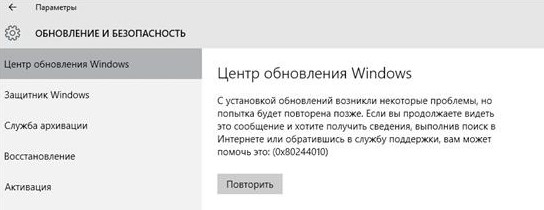
Если вы увидели ошибку получения или установки обнволения в графической Control Panel или панели Settings, нужно открыть лог агента WindowsUpdate.log. В старых версиях Windows 7 и 8 это файл
%Windir%\WindowsUpdate.log
. В современных Windows 10/11 и Windows Server 2022/2019 вы можете сгенерировать файл WindowsUpdate.log с помощью PowerShell:
Get-WindowsUpdateLog -logpath C:\PS\Logs\WindowsUpdate.log
В моем случае в журнале обновлений обнаружились такие ошибки:
PT WARNING: Exceeded max server round trips: 0x80244010 PT WARNING: Sync of Updates: 0x80244010 PT WARNING: SyncServerUpdatesInternal failed: 0x80244010 Agent * WARNING: Failed to synchronize, error = 0x80244010 Agent * WARNING: Exit code = 0x80244010 Agent ********* Agent ** END ** Agent: Finding updates [CallerId = AutomaticUpdates] Agent ************* Agent WARNING: WU client failed Searching for update with error 0x80244010 AU >>## RESUMED ## AU: Search for updates [CallId = {128CCEAD-F84D-405E-9BC2-607D1694894B}]
AU # WARNING: Search callback failed, result = 0x80244010 AU # WARNING: Failed to find updates with error code 80244010
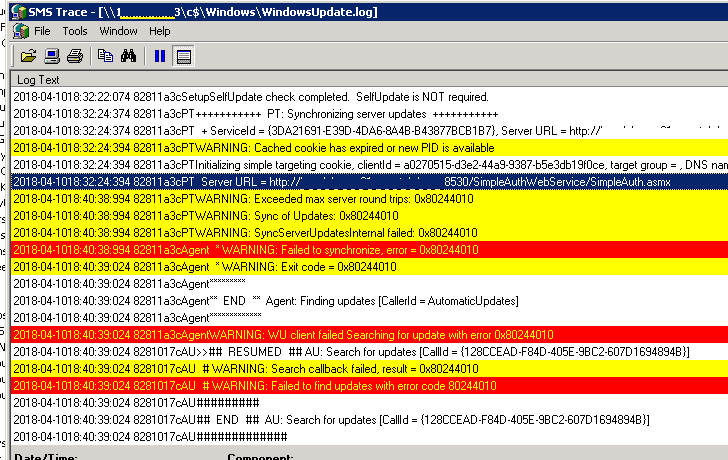
Обратите внимание на строку Exceeded max server round trips: 0x80244010. Эта ошибка говорит, что при обращении к серверу обновлений (в моем случае это WSUS) было превышено максимальное количество обращений. В результате чего сервер обновлений отключает клиента, который превысил лимит обращений (по умолчанию лимит — 200 обращений).
Также в Windows Update есть ограничение в 200 Кб на максимальный размер XML файла, который клиент получает с сервера в рамках одного обращения. Чем большее количество обновлений на сервере для клиента нужно проверить, тем больший размер XML файла. Если клиент не смог получить необходимые данные с сервера обновлений за 200 сессий, он временно отключается от сервера и возвращает ошибку.
Чаще всего такая ошибка возникает из-за плохого или нестабильного сетевого соединения с сервером обновлений, или когда клиенту нужно получить слишком большое количество обновлений (новый клиент сервера WSUS или компьютер, на котором давно не устанавливались обновлений).
В большинстве случаев пользователю достаточно через несколько минут повторно нажать на кнопку Retry/ Check for Updates в панели управления или выполнить команду:
wuauclt.exe / detectnow
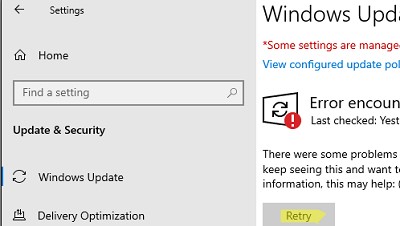
В большинстве случаев это решает проблему, но в том случае если клиентов в сети много, такой способ решения проблемы неприемлем.
По умолчанию клиент проверяет обновления на сервере каждые 22 часа. Вы можете изменить этот интервал с помощью параметров групповых политик компьютера. Откройте редактор локальной GPO (
gpedit.msc
) или отредактируйте доменные политику в консоли Group Policy Management Console (
gpmc.msc
). Перейдите в раздел Computer Configuration -> Administrative Templates -> Windows Components -> Windows Update.
Включите параметр Automatic Update detection frequency и увеличьте частоту синхронизаций клиента с сервером обновлений до 3 часов.
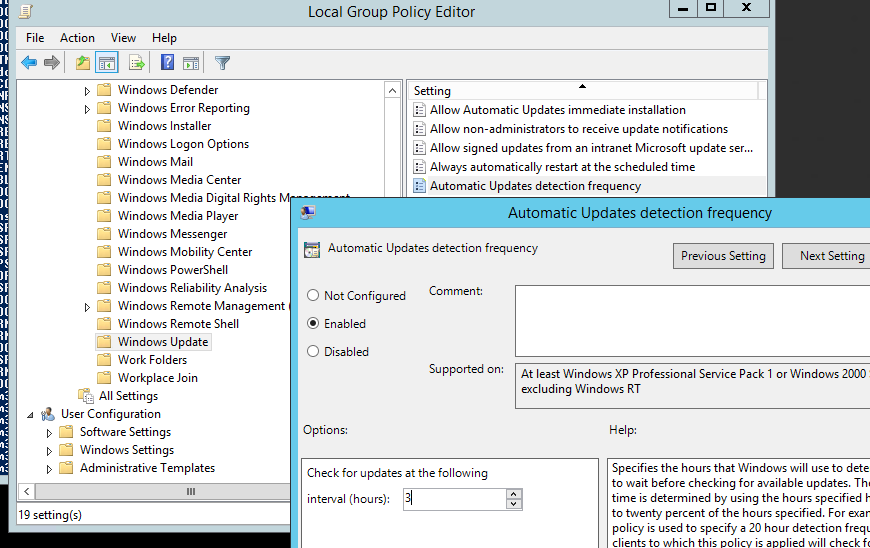
Также можно на стороне сервера WSUS убрать ограничение на максимальный размер XML файла, который может скачать клиент с сервера. Для этого откройте SQL Server Management Studio и подключитесь к базе данных SUSDB. Выполните выполнить следующую команду T-SQL.
USE SUSDB
GO
Проверьте и запомните текущее значение:
select MaxXMLPerRequest from tbConfigurationC
Отключите ограничение:
UPDATE tbConfigurationC SET MaxXMLPerRequest = 0
Чтобы не менять настройки в базе WSUS, можно выполнить очистку WSUS сервера с помощью встроенного мастера очистки (Консоль Update Service -> Options -> Server Cleanup Wizard -> все опции -> Next). Это удалит старые, неиспользуемые, и замененные обновления (особенно много мусора от обновлений MS Office), из-за которых может долго выполняться сканирование.
В результате такой операции, клиент Windows Update будет получать намного меньше мета-информации с WSUS сервера, и его взаимодействие должно уместиться в 200 сессий по 200кб.

Также попробуйте увеличить производительность пула WsusPool в IIS на сервере WSUS по рекомендация из стати Ошибка обновления Windows 80244022
WsusPool (Application Pools -> WsusPool -> Advanced settings):
- Private Memory Limit (KB) – 0 (убрать лимит 1.2 на использование RAM рабочим процессов WSUS)
- Queue Length — 25000 (увеличить длину очереди к пулу приложения с 10000)
- Limit Interval (minutes) — 15 (увеличить минут время для сброса счетчиков и выполнения CPU Throttling с 5 минут до 15)
- Service Unavailable Response — TcpLevel (при старом значение HttpLevel клиенту возвращается ошибка HTTP 503)
Отредактируйте файл config ( C:\Program Files\Update Services\WebServices\ClientWebService\web.config), заменив строку
httpRuntime maxRequestLength="4096"
на
httpRuntime maxRequestLength="204800" executionTimeout="7200"
Если все рассмотренные способы не помогли исправить ошибку обновления на клиенте, попробуйте полностью сбросить на нем настройки Windows Update и восстановить настройки по-умолчанию. После чего выполните несколько циклов поиска обновлений.
Did you receive an error code 0x80244010 while attempting to download, install, or update a Windows device? This bug normally appears when you tap “Check for updates” inside the Windows update section. Moreover, this also prompts an error message that reads – “Code 80244010 Windows Update encountered an unknown error“.

What is Error 0x80244010? When does it occur?
The error 0x80244010 is an update-related issue and it primarily occurs when you are attempting to download and install the recent cumulative updates on your Windows PC. The most probable reasons that may invoke this issue are as follows –
- Internal glitches: Restart your computer and this error resolves on its own.
- Corrupt system files or folders: The presence of corrupt files or folders may invoke an update-related issue on your PC. This mostly happens when you are running a third-party antivirus program on your computer. To solve it, you must uninstall or at least disable running an external security app, and then perform an SFC scan on your PC.
- Corruption within the Windows Update components: Purge SoftwareDistribution and Catrrot2 folders and check if this update issue resolves afterward.
- The required services or processes are disabled by some policies: If that’s the case, you must re-configure such policies so that Windows Updates do happen without getting into some error codes.
Now that you know what may invoke an error 0x80244010 in Windows, let’s learn how to resolve this issue in the below section.
How to Fix Windows Update Error Code 80244010
Troubleshooting Windows Update, Running SFC scan, and Resetting Windows components are a few methods that can fix this error 0x80244010 on Windows 10. If not, go to the Update Catalog, download the pending update’s “.msi file” and apply it to your PC.
Note: There’s an in-built group policy in Windows that must remain enabled and running on your computer for updates to download and install automatically. This policy goes by the name “Detection Frequency Policy”. Check for this policy and re-enable it if you find it disabled or not running on your PC.
To solve the Update Error Code 0x80244010 in Windows 10, use the following workarounds –
Solutions List
- Troubleshoot Windows Update
- Run System File Checker Utility Program
- Scan for Malware using Microsoft Defender
- Reset Windows Update Components
- Manually Install Windows 10 Updates
- Modify Automatic Update detection frequency policy
1] Troubleshoot Windows Update
Windows includes a great utility program that can take care of any update-related issues. Before proceeding to any other fixes, you must give “Windows Update Troubleshooter” a try. Here’s how to run this tool –
- Open Windows Settings (using WinKey + I).
- Select Update & Security then Troubleshoot on the left column.
- Head over to the right pane and expand “Windows Update“.
Quick Note: If you are on version 2004, click “Additional troubleshooters” first then “Windows Update” on the upcoming screen.
- When the box expands, hit “Run the troubleshooter”.
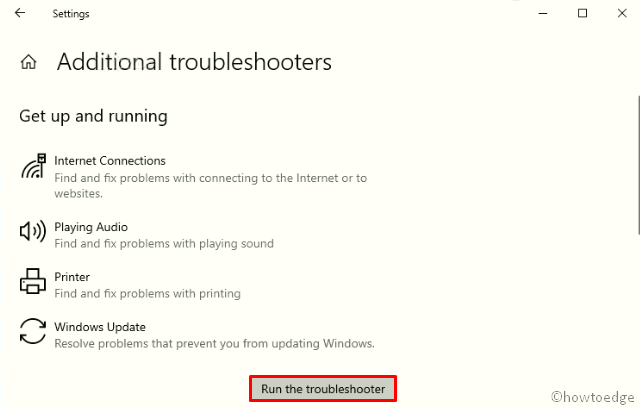
- Follow the on-screen instructions to troubleshoot Windows errors.
2] Run the System File Checker Utility Program
If the troubleshooter doesn’t solve the error 0x80244010, there may lie corrupt files inside Windows. To mitigate obsolete files or re-create missing files, you should run an SFC scan. Here’s how to proceed –
- Right-click anywhere on the Taskbar and click Task Manager.
- Go to the File Menu and hit Run new task.
- Type cmd near the blinking cursor and press Enter, just make sure to check the box beneath.
- On the elevated console, type
sfc /scannowand press the Enter key again.
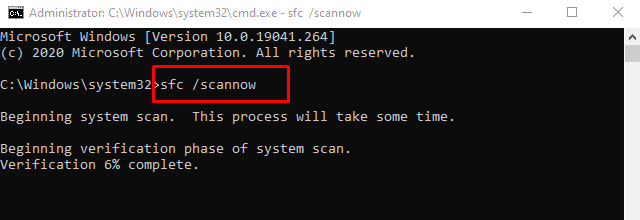
- This approximately takes 10-15 minutes to complete, so wait patiently.
- Once over, Restart the PC so as to make the above changes effective.
Sign back in and check whether you can now update your operating system or not. If still not, try the below fixes –
3] Scan for Malware using Microsoft Defender
Sometimes, the Error code 0x80244010 may occur simply due to some malware infection or virus attack. If that’s the case, open Windows Security and perform a full scan on the PC.
Tip: Windows users should definitely go for the Full system scan once a month to get rid of lurking viruses or trojans.
Third-party antivirus programs are of no use unless you have paid for using their services. If you have installed any such free application, either disable it or remove it completely.
4] Reset Windows Update Components
In case, the error code 0x80244010 still persists, this might be due to the corrupt Windows components. Resetting Windows Update components will surely repair the underlying causes and restore Windows OS back to normal. All you need is to follow the below guideline –
- Launch Command prompt as Admin – Type “CMD” in the search bar then right-click on the top result and choose Run as administrator.
- A UAC prompt will appear afterward, tap Yes to authorize the access.
- Next, execute the following codes one after another. Just make sure to press Enter at the end of each code.
net stop wuauserv net stop cryptSvc net stop bits net stop msiserver
- Doing so will stop certain basic services. Next, rename SoftwareDistribution and Catroot2 folders using the below two codes –
Ren C:\Windows\SoftwareDistribution SoftwareDistribution.old Ren C:\Windows\System32\catroot2 Catroot2.old
- Now, restart the services that you have previously paused –
net start wuauserv net start cryptSvc net start bits net start msiserver
- Restart Windows to make the changes effective from the next login.
- Sign back in and navigate to the following path –
Settings > Update & Security > Windows Update
- Hit the Check for Updates button and if there is any pending update, download and install the same.
5] Manually Install Windows 10 Updates
Many a time, such errors appear after installing a wrongly configured patch update. So, look back and remember if you had recently installed any updates or not. If yes, then roll back the lately installed cumulative update on your PC.
However, if not, you should manually download and install the recent security patch on your computer. To do this, you need to first find out the pending updates “KB” number. Here’s how to find this –
- Jointly press Win+I to open the Settings UI.
- Click Update & Security then Windows Update.
- Head over to the right pane and hit “View Update history”.
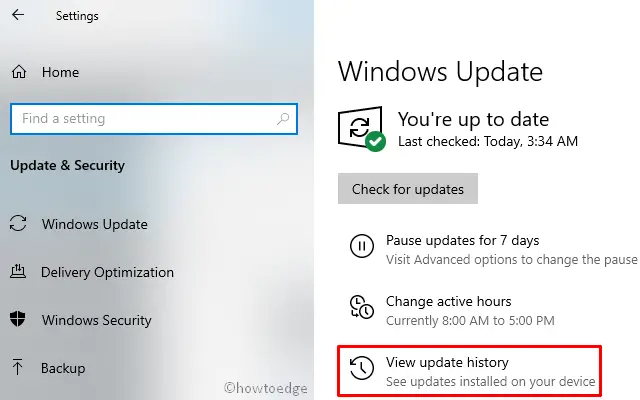
- On the next screen, you may find the list of failed updates.
- Note down the CU number and follow the next part –
Manually Install the Pending Updates
- Visit the Microsoft Update Catalog website and type the “KB” number noted above.
- This will present a list of well-matching results, choose one as per the system architecture.
- Click Download next to the update link and thereafter the top link on the upcoming window.
- When the download completes, click twice on the setup file to upgrade the operating system.
6] Modify Automatic Update detection frequency policy
If none of the above solutions fix the error code 0x80244010, you must try to enable the Detection Frequency policy. Here’s how to do this –
Note: Windows 10 Home users can’t do this as their PC lacks a great feature – Group Policy.
- Type “Group policy” on the search bar and click the best-matching result.
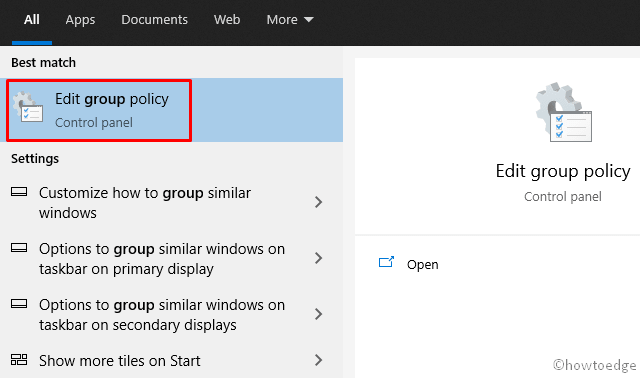
- On the Policy window, browse to the path –
Computer Configuration > Administrative Templates > Windows Components > Windows Updates.
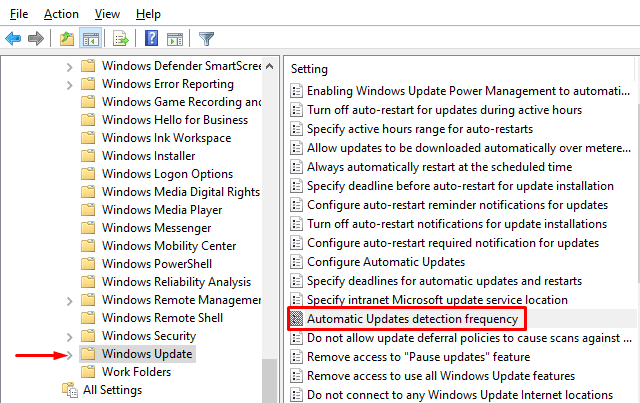
- Once you reach there, move right-side and look for the “Automatic Update detection frequency” policy.
- Double-click on this policy and this will open another window.
- Mark the circle left of the “Enabled” option and hit Apply then OK.
That’s it, I hope this article helps to fix the Error Code 0x80244010. If you have any queries or suggestions, write them down in the comment section.
How do I fix Error 0x80244010 in Windows?
Since this is an update-related issue, you may solve it simply by running the Windows Update Troubleshooter. In case the error occurs even after this, you may attempt the fixes discussed above. If all these solutions fail to resolve this issue on your Windows PC, you must manually download and install the pending update on your computer.
Windows Error 0x80244010 generally triggers while installing a new WSUS server for many of the Windows clients.
Our Server Administration Techs handles different issues that cause this error on a daily basis.
Today, let us discuss various methods to fix ‘Windows Error 0x80244010’ and restore Windows update subsystem functionality.
Windows Error 0x80244010 – Causes

After installing a new WSUS server, many Windows clients could not receive new updates, resulting in the error 0x80244010. This error is typical also for the devices that receive updates directly from Windows Update servers.
An Overview:
- Causes of Windows Error 0x80244010
- Reasons Behind System File Corruption
- Methods to troubleshoot Windows Error 0x80244010
Causes of Windows Error 0x80244010
Major causes of Windows Error 0x80244010 include:
-
Generic glitch
Generic glitch is quite common on Windows endpoint machines. Microsoft already has a selection of built-in repair strategies that are ready to deploy.
We can attempt to fix it by running the built-in Windows Update troubleshooter and by applying the fix that it recommends.
-
Corrupt File in the WU temp folders
Similarly, another scenario is a corrupt temp file in the SofwareDistribution or Catroot2folders. This may occur after a botched update or after an AV scan.
In this scenario, we can fix the issue by running a series of commands capable of resetting every WU component including the two temp folders.
-
The machine cannot update conventionally
Under certain circumstances, the WU component might not work automatically.
If the WU function is blocked at a system level, we can most likely fix the issue. Use the System Update Readiness tool to install the updates that are failing to install conventionally.
-
Disabled Detection Frequency policy
When the client exceeds the default number of allowed trips to the WSUS server, it encounters this issue on a Windows Server.
To fix this issue, we have to use the Local Group Policy editor to enable the Automatic Update detection policy and set a global updating interval.
-
System File Corruption
On the other hand, if the Windows Update troubleshooter isn’t able to fix the issue automatically, the affected system may have an underlying corruption issue that cannot resolve conventionally.
In this case, we can fix the issue by refreshing every Windows component with Clean install or Repair install (in-place repair).
First, to diagnose the problem, open the WindowsUpdate.log, which is located in %Windir% folder.
2018-10-04 16:10:28:661 121 2a2b2 PT WARNING: Exceeded max server round trips: 0x80244010 2018-10-04 16:10:28:661 121 2a2b2 PT WARNING: Sync of Updates: 0x80244010 2018-10-04 16:10:28:661 121 2a2b2 PT WARNING: SyncServerUpdatesInternal failed: 0x80244010 2018-10-04 16:10:28:661 121 2a2b2 Agent * WARNING: Failed to synchronize, error = 0x80244010 2018-10-04 16:10:29:042 282 2a2b2 Agent * WARNING: Exit code = 0x80244010 2018-10-04 16:10:29:042 282 2a2b2 Agent ********* 2018-10-04 16:10:29:042 282 2a2b2 Agent ** END ** Agent: Finding updates [CallerId = AutomaticUpdates] 2018-10-04 16:10:29:042 282 2a2b2 Agent ************* 2018-10-04 16:10:29:042 282 2a2b2 Agent WARNING: WU client failed Searching for update with error 0x80244010 2018-10-04 16:10:29:042 282 2221c AU >>## RESUMED ## AU: Search for updates [CallId = {128CCEAD-F84D-405E-9BC2-607D1694894B}] 2018-10-04 16:10:29:042 282 2221c AU # WARNING: Search callback failed, result = 0x80244010 2018-10-04 16:10:29:042 282 2221c AU # WARNING: Failed to find updates with error code 80244010
Make note of the error, “Exceeded max server round trips: 0x80244010″. It means that the maximum number of requests to the update server (WSUS) exceeds while scanning for updates.
This is also indicated by the Windows Update error code, according to the table (SUS_E_PT_EXCEEDED_MAX_SERVER_TRIPS).
The server disconnects a client that exceeds the maximum trip number. The trip limit in the Windows update receiving protocol is set as 200 trips by default.
Similarly, there is a limit on the maximum size of an XML file the client can download from the update server during a trip – 200 KB. The greater number of updates on the server, the larger the size of the downloading XML file.
If a client fails to obtain the necessary data in 200 trips, it disconnects from the server, resulting in error 0x80244010.
Let us now look into system file corruption in detail.
Reasons Behind System File Corruption
There are dozens of reasons why Windows files or system files might get corrupt, but among the most common are:
-
Unstable network connection:
As a rule, this occurs due to the poor or unstable network connection to the WSUS server or if a client wants to receive too many updates.
The easiest way is to click the ‘Try Again’ button on a client several times in the Windows Update section of the Control Panel or run the command:
Once we start the search for updates, wait for 15 minutes for the previous cycle of update search to finish.
In most cases, this can solve the problem, but if there are a lot of clients in the network, this method is not acceptable.
-
Unsynchronized updates
We can synchronize the updates using the group policy, “Automatic Update detection frequency”. Go to, Computer Configuration -> Administrative Templates -> Windows Components -> Windows Update.
Automatic Update detection frequency specifies the number of hours that Windows will wait before checking for available updates. The exact wait time is found by using the number of hours specified minus a random value between 0 and 20 percent of that number.
For example, if this policy is used to specify a 20-hour detection frequency, then all computers with this policy will check for updates anywhere between 16 and 20 hours.
If the status is set as Enabled, Automatic Updates will check for available updates at specific intervals.
Similarly, If the status is set as Disabled or Not Configured, Automatic Updates will check for available updates at the default interval of 22 hours.
We can also remove the limit on the maximum XML file size that the client can download from the WSUS server.
To do it, run the following command in WSUSDB database:
USE SUSDB GO UPDATE tbConfigurationC SET MaxXMLPerRequest = 0
If we do not want to change our WSUS database settings, clean up the WSUS server using the integrated Cleanup Wizard (Update Service console -> Options -> Server Cleanup Wizard -> all options -> Next). Then, remove old, not in use updates.
As a result, the Windows Update client will get less meta-information from the WSUS server, and the interaction will fit in 200 sessions of 200 KB each.
[Bobcares support techs rely on a systematic troubleshooting approach as much as we focus on the right tools for the job.]
Methods to troubleshoot Windows Error 0x80244010
Windows Error 0x80244010 and its solution involve various steps. Let’s have a detailed look into it:
-
Run the Windows Update troubleshooter
To launch the Windows Update troubleshooter on Windows 7 in order to fix the 80244010 error, follow the below steps:
- Press Windows key + R to open up a Run dialog box
- Type ‘control’ and press Enter to open up the classic Control Panel interface
- Once inside, use the search function in the top-right corner to search for ‘troubleshoot’
- Then, from the list of results, click on Troubleshooting to expand on the list of integrated troubleshooters
- In Troubleshoot computer problem screen, click on System and Security from the list of available options
- Click on ‘Windows Update’ under the ‘Windows category’
- After we successfully manage to open the troubleshooter, start by clicking on the Advanced button and checking the box along with Apply repairs automatically
- Once its done, click on Next to advance to the next menu.
- Wait for the initial scan to complete, then click on Apply this fix if the repair strategy is not done automatically.
- When prompted to restart, do so and see if the issue is resolved at the next system startup by attempting to use the Windows Update feature again.
-
Reset WU components
- Press Windows key + R to open up a Run dialog box
- Type ‘cmd‘ inside the text box and press ‘Ctrl + Shift + Enter’ to open up a Command Prompt
- In case you find the UAC (User Account Control), click Yes to grant admin access.
- Once inside, type the following commands and press ‘Enter’ after each one:
net stop wuauserv net stop cryptSvc net stop bits net stop msiserver
- These successive commands will stop the Windows Update service, the MSI Installer, the Cryptographic service, and the BITS service.
- Run the following commands in the same CMD window and press Enter after each one to rename the two folders responsible for storing temporary WU files (SoftwareDistribution and Catroot2):
ren C:WindowsSoftwareDistribution SoftwareDistribution.old ren C:WindowsSystem32catroot2 Catroot2.old
- Renaming these two folders will force the Windows Update component to create new folders and prevent any corrupt files from affecting the updating operations
- After the two folders rename, run these final commands in quick succession (press Enter after each one) to start the same services that we disabled at step 2:
net start wuauserv net start cryptSvc net start bits net start msiserver
- Once the service restarts, repeat the action that was previously causing the Windows Update 80244010 error and see if the resolve it done.
-
Run the System Update Readiness Tool
- Visit the URL https://www.microsoft.com/en-us/download/details.aspx?id=20858 and download the latest version of the System Update Readiness Tool. Once it’s done, select the language and click the Download button for the latest version.
- Keep in mind that the download is quite large, so wait patiently.
- Once the download is complete, open the System Update Readiness Tool executable and wait for the initial scan to complete.
- We can see the utility downloading and installing the updates that were previously failing with the 80244010 error.
- After the operation is complete, restart your computer and see if the fix is done.
-
Enable the Detection Frequency policy
To set Automatic Update detection frequency, follow the steps given below:
- In the Group Policy Object Editor, expand Computer Configuration, expand Administrative Templates, expand Windows Components
- Then click ‘Windows Update’
- In the details pane, click Automatic Update detection frequency, click Enabled, and type the number of hours for the detection interval
- Click OK
- Refresh OS components
-
Clean install:
On one hand, this procedure is the easiest, but the disadvantage is that unless you back up your data, you will lose personal files. As opposed to a clean install, this procedure does not require compatible installation media.
-
Repair install (in-place upgrade):
Likewise, this procedure will require to use a compatible installation media. We will have to be technical, but the advantage is that the operation will only touch the Windows files. This means, all your personal files & settings will remain untouched.
If neither of the methods helps fix the update error, clear Windows Update temporary cache and try to search for updates several times.
-
Stop Windows Update service
- Click ‘Start’ and type for “services.msc”,
- In search results “services.msc” should show up. Open it,
- A new window will open containing all Windows services,
- Search for ‘Windows Update’
- Right-click on ‘Windows Update’ and click ‘Stop’.
-
Clear the Windows Update temporary cache folder
- Hold windows-key pressed and hit “R” key simultaneous,
- A small new window will appear,
- Type %windir%SoftwareDistributionDataStore in this new window and click OK,
- This will open Windows Explorer in the correct location,
- Delete all contents of this folder.
-
Start the Windows Update Service again
- Switch back to the windows Services,
- Locate Windows Update,
- Right-click on it and choose Start.
[Looking for assistance to fix windows errors? We are here for you!]
Conclusion
To conclude, WSUS Windows Error 0x80244010 can occurs due to several reasons including, generic glitch, corrupt file in the WU temp folders, system file corruption and so on. Today, we saw how our Support Engineers systematically troubleshoot the WSUS Windows Error 0x80244010.
PREVENT YOUR SERVER FROM CRASHING!
Never again lose customers to poor server speed! Let us help you.
Our server experts will monitor & maintain your server 24/7 so that it remains lightning fast and secure.
GET STARTED
var google_conversion_label = «owonCMyG5nEQ0aD71QM»;
In the process of installing a new WSUS server, most Windows users experiences Windows Error 0x80244010.
Here at Ibmi Media, we regularly help our Customers to fix Windows related issues as part of our Server Management Services.
In this context, we shall look into the different ways to solve «Windows Error 0x80244010» and restoring Windows update subsystem functionality.
What triggers Windows Error 0x80244010?
When this error occurs, you will see an error message such as this;
Windows could not search for new updates
An error occurred while checking for new updates for your computer.
Error(s) found;
Code 0x80244010 Windows Update encountered an unknown error.
This error generally happens after installing a new WSUS server.
This error is typical also for the devices that receive updates directly from Windows Update servers.
The Main causes of Windows Error 0x80244010 includes:
1. Generic glitch
Generic glitch is quite common on Windows endpoint machines. Microsoft already has a selection of built-in repair strategies that are ready to deploy.
We can attempt to fix it by running the built-in Windows Update troubleshooter and by applying the fix that it recommends.
2. Corrupt File in the WU temp folders
Similarly, another scenario is a corrupt temp file in the SofwareDistribution or Catroot2folders. This may occur after a botched update or after an AV scan.
In this scenario, we can fix the issue by running a series of commands capable of resetting every WU component including the two temp folders.
3. The machine cannot update conventionally
Under certain circumstances, the WU component might not work automatically.
If the WU function is blocked at a system level, we can most likely fix the issue. Use the System Update Readiness tool to install the updates that are failing to install conventionally.
4. Disabled Detection Frequency policy
When the client exceeds the default number of allowed trips to the WSUS server, it encounters this issue on a Windows Server.
To fix this issue, we have to use the Local Group Policy editor to enable the Automatic Update detection policy and set a global updating interval.
5. System File Corruption
On the other hand, if the Windows Update troubleshooter isn’t able to fix the issue automatically, the affected system may have an underlying corruption issue that cannot resolve conventionally.
In this case, we can fix the issue by refreshing every Windows component with Clean install or Repair install (in-place repair).
First, to diagnose the problem, open the WindowsUpdate.log, which is located in %Windir% folder. Then you will see a report such as this;
2018-10-04 16:10:28:661 121 2a2b2 PT WARNING: Exceeded max server round trips: 0x80244010 2018-10-04 16:10:28:661 121 2a2b2 PT WARNING: Sync of Updates: 0x80244010 2018-10-04 16:10:28:661 121 2a2b2 PT WARNING: SyncServerUpdatesInternal failed: 0x80244010 2018-10-04 16:10:28:661 121 2a2b2 Agent * WARNING: Failed to synchronize, error = 0x80244010 2018-10-04 16:10:29:042 282 2a2b2 Agent * WARNING: Exit code = 0x80244010 2018-10-04 16:10:29:042 282 2a2b2 Agent ********* 2018-10-04 16:10:29:042 282 2a2b2 Agent ** END ** Agent: Finding updates [CallerId = AutomaticUpdates] 2018-10-04 16:10:29:042 282 2a2b2 Agent ************* 2018-10-04 16:10:29:042 282 2a2b2 Agent WARNING: WU client failed Searching for update with error 0x80244010 2018-10-04 16:10:29:042 282 2221c AU >>## RESUMED ## AU: Search for updates [CallId = {128CCEAD-F84D-405E-9BC2-607D1694894B}] 2018-10-04 16:10:29:042 282 2221c AU # WARNING: Search callback failed, result = 0x80244010 2018-10-04 16:10:29:042 282 2221c AU # WARNING: Failed to find updates with error code 80244010
Make note of the error, «Exceeded max server round trips: 0x80244010«. It means that the maximum number of requests to the update server (WSUS) exceeds while scanning for updates.
This is also indicated by the Windows Update error code, according to the table (SUS_E_PT_EXCEEDED_MAX_SERVER_TRIPS).
The server disconnects a client that exceeds the maximum trip number. The trip limit in the Windows update receiving protocol is set as 200 trips by default.
Similarly, there is a limit on the maximum size of an XML file the client can download from the update server during a trip – 200 KB. The greater number of updates on the server, the larger the size of the downloading XML file.
If a client fails to obtain the necessary data in 200 trips, it disconnects from the server, resulting in error 0x80244010.
Let us now look into system file corruption in detail.
1. System File Corruption
There are dozens of reasons why Windows files or system files might get corrupt, but among the most common are:
i. Unstable network connection:
As a rule, this occurs due to the poor or unstable network connection to the WSUS server or if a client wants to receive too many updates.
The easiest way is to click the «Try Again» button on a client several times in the Windows Update section of the Control Panel or run the command:
wuauclt.exe /detectnow
Once we start the search for updates, wait for 15 minutes for the previous cycle of update search to finish.
In most cases, this can solve the problem, but if there are a lot of clients in the network, this method is not acceptable.
ii. Unsynchronized updates
We can synchronize the updates using the group policy, “Automatic Update detection frequency”. Go to, Computer Configuration -> Administrative Templates -> Windows Components -> Windows Update.
Automatic Update detection frequency specifies the number of hours that Windows will wait before checking for available updates. The exact wait time is found by using the number of hours specified minus a random value between 0 and 20 percent of that number.
For example, if this policy is used to specify a 20-hour detection frequency, then all computers with this policy will check for updates anywhere between 16 and 20 hours.
If the status is set as Enabled, Automatic Updates will check for available updates at specific intervals.
Similarly, If the status is set as Disabled or Not Configured, Automatic Updates will check for available updates at the default interval of 22 hours.
We can also remove the limit on the maximum XML file size that the client can download from the WSUS server.
To do it, run the following command in WSUSDB database:
USE SUSDB GO UPDATE tbConfigurationC SET MaxXMLPerRequest = 0
If we do not want to change our WSUS database settings, clean up the WSUS server using the integrated Cleanup Wizard (Update Service console -> Options -> Server Cleanup Wizard -> all options -> Next). Then, remove old, not in use updates.
As a result, the Windows Update client will get less meta-information from the WSUS server, and the interaction will fit in 200 sessions of 200 KB each.
[Ibmi Media Support Experts rely on a systematic troubleshooting approach as much as we focus on the right tools for the job.]
Methods to troubleshoot Windows Error 0x80244010?
Windows Error 0x80244010 and its solution involves various steps. Now, let us have a detailed look into it:
1. Run the Windows Update troubleshooter
To launch the Windows Update troubleshooter on Windows 7 in order to fix the 80244010 error, follow the below steps:
i. Press Windows key + R to open up a Run dialog box
ii. Type ‘control’ and press Enter to open up the classic Control Panel interface
iii. Once inside, use the search function in the top-right corner to search for ‘troubleshoot’
iv. Then, from the list of results, click on Troubleshooting to expand on the list of integrated troubleshooters
v. In Troubleshoot computer problem screen, click on System and Security from the list of available options
vi. Click on ‘Windows Update’ under the ‘Windows category’
vii. After we successfully manage to open the troubleshooter, start by clicking on the Advanced button and checking the box along with Apply repairs automatically
viii. Once its done, click on Next to advance to the next menu.
ix. Wait for the initial scan to complete, then click on Apply this fix if the repair strategy is not done automatically.
x. When prompted to restart, do so and see if the issue is resolved at the next system startup by attempting to use the Windows Update feature again.
2. Reset WU components
i. Press Windows key + R to open up a Run dialog box
ii. Type ‘cmd‘ inside the text box and press ‘Ctrl + Shift + Enter’ to open up an elevated Command Prompt.
iii. In case you find the UAC (User Account Control), click Yes to grant admin access.
iv. Once inside, type the following commands and press ‘Enter’ after each one:
net stop wuauserv net stop cryptSvc net stop bits net stop msiserver
v. These successive commands will stop the Windows Update service, the MSI Installer, the Cryptographic service, and the BITS service.
vi. Run the following commands in the same elevated CMD window and press Enter after each one to rename the two folders responsible for storing temporary WU files (SoftwareDistribution and Catroot2):
ren C:\Windows\SoftwareDistribution SoftwareDistribution.old ren C:\Windows\System32\catroot2 Catroot2.old
vii. Renaming these two folders will force the Windows Update component to create new folders and prevent any corrupt files from affecting the updating operations
viii. After the two folders rename, run these final commands in quick succession (press Enter after each one) to start the same services that we disabled at step 2:
net start wuauserv net start cryptSvc net start bits net start msiserver
ix. Once the service restarts, repeat the action that was previously causing the Windows Update 80244010 error and see if the resolve it done.
3. Run the System Update Readiness Tool
i. Visit the URL https://www.microsoft.com/en-us/download/details.aspx?id=20858 and download the latest version of the System Update Readiness Tool. Once it’s done, select the language and click the Download button for the latest version.
ii. Keep in mind that the download is quite large, so wait patiently.
iii. Once the download is complete, open the System Update Readiness Tool executable and wait for the initial scan to complete.
iv. We can see the utility downloading and installing the updates that were previously failing with the 80244010 error.
v. After the operation is complete, restart your computer and see if the fix is done.
4. Enable the Detection Frequency policy
To set Automatic Update detection frequency, follow the steps given below:
i. In the Group Policy Object Editor, expand Computer Configuration, expand Administrative Templates, expand Windows Components
ii. Then click ‘Windows Update’
iii. In the details pane, click Automatic Update detection frequency, click Enabled, and type the number of hours for the detection interval
iv. Click OK
v. Refresh OS components
5. Clean install:
On one hand, this procedure is the easiest, but the disadvantage is that unless you back up your data, you will lose personal files. As opposed to a clean install, this procedure does not require compatible installation media.
6. Repair install (in-place upgrade):
Likewise, this procedure will require to use a compatible installation media. We will have to be technical, but the advantage is that the operation will only touch the Windows files. This means, all your personal files & settings will remain untouched.
If neither of the methods helps fix the update error, clear Windows Update temporary cache and try to search for updates several times.
7. Stop Windows Update service
i. Click ‘Start’ and type for “services.msc”,
ii. In search results “services.msc” should show up. Open it,
iii. A new window will open containing all Windows services,
iv. Search for ‘Windows Update’
v. Right-click on ‘Windows Update’ and click ‘Stop’.
8. Clear the Windows Update temporary cache folder
i. Hold windows-key pressed and hit “R” key simultaneous,
ii. A small new window will appear,
iii. Type %windir%\SoftwareDistribution\DataStore in this new window and click OK,
iv. This will open Windows Explorer in the correct location,
v. Delete all contents of this folder.
9. Start the Windows Update Service again
i. Switch back to the windows Services,
ii. Locate Windows Update,
iii. Right-click on it and choose Start.
[Looking for assistance to fix windows errors? We are available to help you today!]
Readers help support Windows Report. We may get a commission if you buy through our links.
Read our disclosure page to find out how can you help Windows Report sustain the editorial team. Read more
The Windows Update error 80244010 can arise in various Windows platforms. When Windows can’t search for and find new updates, users see an 80244010 error code.
The error message states:
Windows could not search for new updates.
It’s an issue that often arises on desktops or laptops connected to a LAN network. If you need to fix error code 80244010, check out the potential resolutions below.
What causes the windows update error 80244010?
There are several possible causes for the Windows Update error 80244010. Some of the most common causes include:
- Network connectivity issues – This error can sometimes occur if your computer cannot connect to the internet or the Windows Update servers.
- Firewall or antivirus software – Your firewall or antivirus software may be blocking the Windows Update process.
- Corrupted system files – This error can also be caused by corrupted system files, preventing the Windows Update process from completing successfully.
- Insufficient disk space – If your hard drive is full or almost full, this can cause the Windows Update process to fail.
- Pending updates – If you have pending updates waiting to be installed, this can also cause the error 80244010 to occur.
To fix this error, you may need to troubleshoot your network connectivity, and try the suggestions listed below.
How do I fix the Windows Update error 80244010?
1. Run the Windows Updater troubleshooter
First, open the Windows Update troubleshooter, which might provide some resolutions for error 80244010.
- To do that via the Control Panel, press the Windows key + R hotkey.
- Input Control Panel in the Open text box, and click the OK button.
- Select the All Control Panel Items option shown below.
- Click Troubleshooting to open the applet directly below.
- Click View All, and then select Windows Update.
- Click Advanced to select an Apply all repairs automatically option.
- Press the Next button.
- Select the Apply this fix option.
2. Run a System File Checker Scan
As error 80244010 can be due to corrupted system files, a System File Checker scan might resolve it.
- Press the Windows key + S hotkey.
- Enter cmd in the search box.
- Right-click Command Prompt to select Run as administrator.
- Enter this command first:
- DISM.exe /Online /Cleanup-image /Restorehealth.
- Press the Return key after entering.
- Then enter sfc /scannow in the Command Prompt, and press the Return key.
- Wait for the SFC scan to finish. Restart Windows if the scan repairs files.
3. Reset the update components
Resetting Windows Update’s components might fix error 80244010.
- To do that, open the Command Prompt as an administrator.
- Then input the separate commands below:
- net stop wuauserv
- net stop cryptSvc
- net stop bits
- net stop msiserver
- net stop wuauserv
- Enter the command ren C:WindowsSoftwareDistribution SoftwareDistribution.old, and press the Return button.
- Then input ren C:WindowsSystem32catroot2 Catroot2.old in the Prompt, and press the Enter key.
- Input these commands separately to restart their services:
- net start wuauserv
- net start cryptSvc
- net start bits
- net start msiserver
- net start wuauserv
4. Enable the Detection Frequency in Group Policy Editor
If you’re encountering error 80244010 on a network server or client, try enabling Detection Frequency with the Group Policy Editor.
- Open the Run accessory.
- Input gpedit.msc in the Open box and click OK to open Group Policy Editor.
- Then click Computer Configuration, Administrative Templates, Windows Components, and Windows Updates on the left of Group Policy Editor.
- Double-click the Automatic Update detection frequency policy on the right of the window.
- Select the Enabled option.
- Then enter a value less than the default 22 in the interval text box.
- Click the Apply option.
- Click OK to close the window.
5. Reset Windows
Resetting Windows to refresh it might also fix error 80244010.
- You can reset Windows 10 by entering reset in the search box.
- Click Reset this PC to open the Settings window as shown directly below.
- Click Get started to open the Reset this PC window.
- Select the Keep my files option.
- Press the Next and Reset buttons.
- Recent Windows 11 update lets you disable profanity filter in voice typing
- Windows 11 KB5055627 update makes File Explorer more fluid
Those are a few of the confirmed fixes for error 80244010. Let us know which of these solutions worked for your PC by leaving us a message in the comments section below.
Matthew Adams
Windows Hardware Expert
Matthew is a freelancer who has produced a variety of articles on various topics related to technology. His main focus is the Windows OS and all the things surrounding it.
He is passionate about the tech world, always staying up-to-date with the latest and greatest. With an analytical view, he likes problem-solving, focusing on errors and their causes.
In his free time, he likes to read and write about history and tries to always develop new skills.








